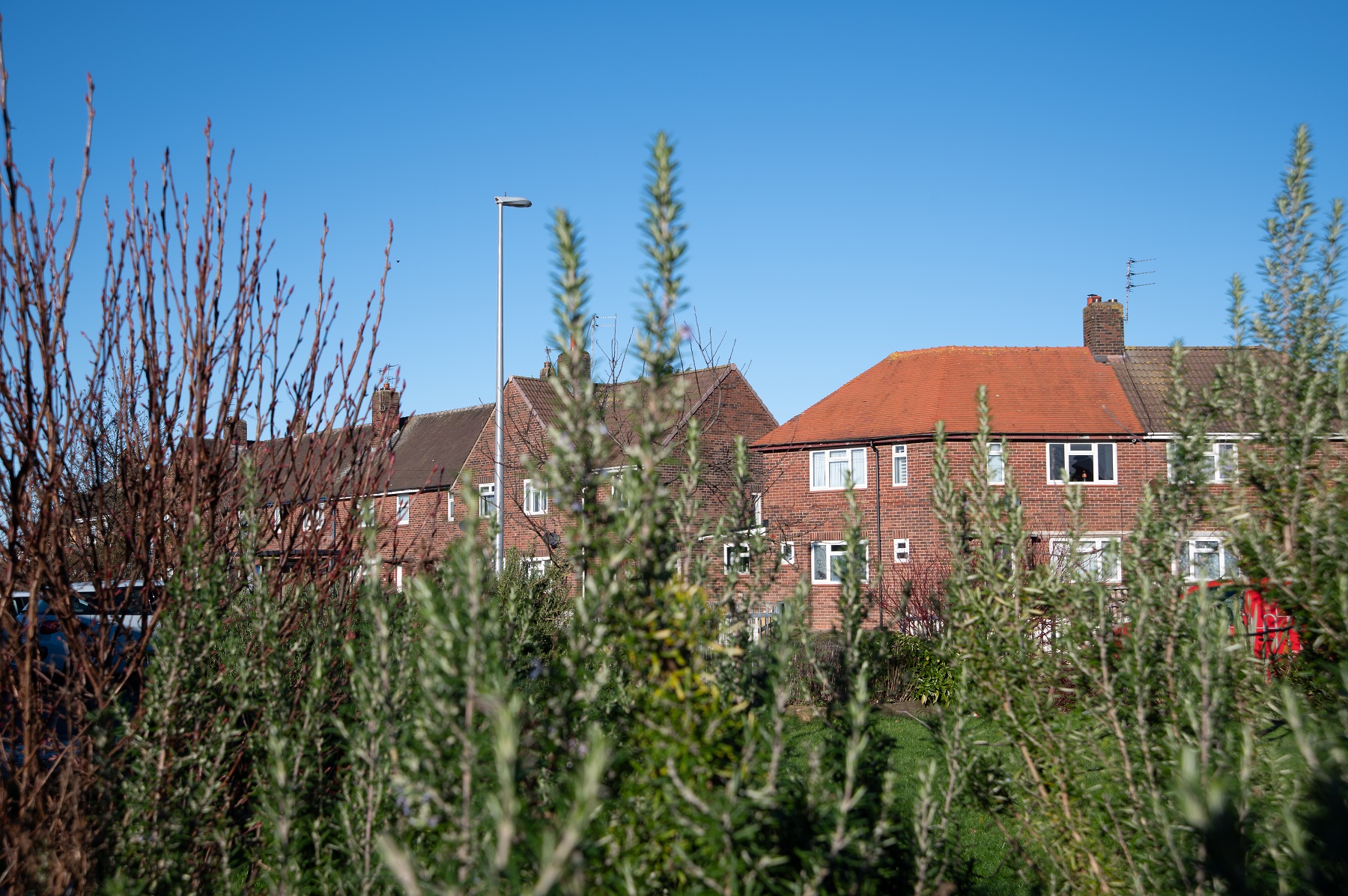Mould so bad you can taste it inside this Blackpool home
A landlord has been served a hazard awareness notice after The Blackpool Lead shared photos of Jade’s mouldy home with the council. But it's a problem in every one of the town’s 18,000 privately rented houses.
Even if Jade’s children’s bedrooms weren’t riddled with black mould she still wouldn’t want them climbing up and down the stairs to get to them. Her sodden carpets have all been ripped up and sent to the tip and when she stands on the wet steps she says she can feel them buckle.
“The stairs are falling apart,” she says. “They don’t feel safe at all.”
At the moment her family of five are all confined to living in one room of her house in Marton. On Jade’s living room floor there are mattresses for her, her mum, her 15-year-old sister and one-year-old son. A small bed for her six-year-old daughter, who has Down’s Syndrome and had heart surgery in September, is one of the few sticks of furniture in the house that hasn’t been claimed by the rampant black mould that has taken over her home.
“I’ve been through three cots for the baby,” says the 33 year old. “My sofa was soaking wet so I had to throw it out.”
Jade and her mum Angela have been trying to keep the mould in their four bedroom home at bay for months.
“When a big storm came in October-November time that must have been when it damaged the roof,” she says. “Then come January the mould started appearing. We were scrubbing it but it wasn’t budging. No matter how much we washed it, it just kept coming back.”
A coordinated effort of cleaning with bleach and mould spray and emptying endless boxes of salt into corners to absorb the damp did little to stop its spread.
“It’s the whole house. We’re keeping everything in suitcases and plastic boxes to try and preserve clothes. It’s in my kitchen cupboards – I’m wiping them out a ridiculous amount but my food is constantly going mouldy. I’ve bought plastic tubs to store cereal which otherwise gets mouldy straight away. I bought a bread bin but if I buy a loaf it still turns mouldy in a day.
“Sometimes I’ve gone days without eating so that the kids can. I’m throwing so much away and having to rely on tins. If I had the funds I’d be out of here today. I’ve even said to my mum, let’s just live in the bloody car.”
Jade and Angela’s battle against black mould is one they have been fighting, until now, in silence. It’s taken its toll on their physical health – the family are often sick with coughs and colds – and their mental health too.
“My mum won’t go out. The mould has ripped through her immune system and she feels so embarrassed. None of my friends know. I’m embarrassed to say this is how I’m living. They ask to come round to see us and how many more excuses can I make?”
It’s difficult for her to leave the house too. She currently has no buggy for her son after his last one became covered in mould from sitting in her hallway. Her children’s toys have all met the same fate. Brand new ones bought at Christmas have had to go in the bin. Her children currently have one toy each – a plastic steering wheel bought from a charity shop for £2.50 for her son, and her daughter has a dolls house that the family found on the street and fixed up.
“I don’t know what to do. I’m embarrassed and I don’t know where to turn. My mental health has taken a hit because I think, how am I allowing my kids to live like this? I never thought I would but there’s nothing I can do.”
It's time for the government to act
Though she’s often felt it, Jade is not alone in her battle with her damp home. In February, analysis of the English Housing Survey by the Institute of Health Equity and Friends of the Earth revealed almost 10m households are living in cold, damp or poorly insulated homes. Around 11 per cent of houses in the private rented sector have damp problems compared with 4 per cent in the social-rented sector and 2 per cent of owner-occupied homes.
But in Blackpool the problem is much worse. Following a request from the government, Blackpool Council provided figures in September that revealed every one of the town’s 18,000 houses in the private rented sector has a damp and mould problem. One in four were classed as a category 1, a serious threat to health and safety. In the most densely populated areas, this applies to 70 per cent of privately rented properties.
Blackpool Council acknowledges that failed private rented housing creates the conditions for the town having the lowest life expectancy in England. It says that the current measure of suitability in the private rented sector – the Housing Health and Safety Rating System – “is not sufficient to ensure that people renting privately have homes that are fit for purpose”.
“Everyone should be entitled to a decent home in the 21st century. Reforms are long overdue and it is now time for the government to act,” it says.
In January 2023 the council introduced an enforcement team to inspect private rented properties in the Blackpool’s most deprived areas. Using £1.2m using of levelling up funding it called on legislative powers to drive up standards where accommodation has fallen into decay. Last month the council announced a further £90m of levelling up funding had been secured to tackle housing in deprived inner areas of the town, some of which it said would be used to acquire and improve existing housing, though that’s unlikely to include Jade’s former council house in Marton.
Living in a mouldy home can cause or exacerbate respiratory problems including infections, allergies or asthma and can affect the immune system. Babies, children and older people are the most vulnerable to it, along with people with existing health problems. Long-term exposure can be fatal.
In 2020 two-year-old Awaab Ishak died as a direct result of exposure to black mould in the flat he lived in in Rochdale. The coroner said his death was a “defining moment” for the housing sector in terms of “increasing knowledge, increasing awareness and a deepening of understanding surrounding the issue of damp and mould”.
Last year, Awaab’s Law was introduced – requiring landlords to investigate and fix reported health hazards within specified timeframes.
Housing charity Shelter says the private rented sector is broken and is applying pressure on the government to pass a strong, amended, Renters Reform Bill into law urgently. Changes such as extending a decent homes standard to properties in the private rented sector, and scrapping section 21 no fault evictions, it says would “deliver the lasting change needed” and “give renters the security and rights they deserve”.
Jade pays £800 a month for her privately rented house. In February, she says, her landlord increased the cost from £625 without notice. Housing charities and Blackpool Council advise tenants experiencing damp and mould that their first port of call should be their landlord but Jade says requests to hers to tackle the problems at the property have resulted in little action.

Inside Jade's home in Blackpool
Damage to the roof following storm damage appears to be the major problem but Jade says her landlord has told her it’s the result of a chimney stack being removed and not properly capped off prior to her tenancy. She says water also flows freely into her conservatory, which is not properly attached to the house. Her landlord attempted to fix this on her request, she says, by filling in gaps with expanding foam that has since disintegrated with more heavy rainfall.
When she complained to him about needing to buy another cot for her one-year-old son, he brought her round a Moses basket suitable for a newborn.
The Blackpool Lead contacted Jade’s landlord but no comment was provided.
Support
Sarah Southworth is a community campaigner who was evicted from her damp home. She points out that many tenants are scared to approach their landlords with problems for fear of being served with a section 21 no fault eviction.
“They’ll try and hush you,” she says. “What my landlord tried to do was, because there was that much that needed doing, he’d come round to do one thing just to appease me. Then he would promise me he would come round in two weeks to do the next job and then he didn’t. It’s mind games. Eventually he said he couldn’t afford the repairs and chose to sell up. I had six weeks to find a new house. It was horrible.”
Southworth set up a community campaign during the pandemic to help families on the Fylde Coast who were struggling to afford food. The group has since expanded into a 7,000+ strong Facebook community that donates unwanted household items and baby equipment to families in need.
Now she has teamed up with Kelly Thorn who runs Sparrowhawk Legal – a legal firm fighting for better housing conditions for women and families. The pair have set up the Women & Family Tenant Support Facebook group to empower women like Jade with emotional support and practical advice on how to improve their situations. They are also keen to assure them there is no shame in coming forward and telling someone they are struggling with damp and mould. They commend Jade for speaking up and hope that her story will embolden others to do so too.
“The whole idea of the group is to give people the support they need. It’s about helping them clarify their thoughts and helping them to make some decisions and do something about it, because you don’t know what you don’t know,” says Thorn.
She points out that navigating complicated complaints processes and civil or legal procedures is a minefield of information that even professionals struggle to understand at times. Navigating them without any prior knowledge, while caring for a baby and a disabled child, trying to stave off mould and dealing with the health implications of it, is another thing entirely.
“You can literally taste the mould as you walk through the door to Jade’s house,” says Thorn, who visited the property in March after Angela shared photographs of it in the support group. “Given what I do for a living I see lots of properties with damp and mould and this is by far one of the worst I’ve ever seen.
“Sometimes you see people doing things like drying clothes on the radiator and it’s clear that it’s misuse of the property, but in this case there’s water coming in through the walls. It’s penetrating damp and the result is rampant mould. The wallpaper is peeling off the walls, rolling down in sheets. The window reveals are black. It’s an absolute disgrace.”
Surveyor Simon Redfearn accompanied Thorn on the visit to Jade’s property and after an initial inspection says his overriding opinion is that the problem is predominantly penetrating damp coming from the chimney stack that they removed in the living room.
“There’s a significant amount of water coming through,” he says. “That's increasing the internal humidity levels which are creating the ideal conditions for damp and mould. There’s a genuine need for repairing the property.”

Inside Jade's home in Blackpool
The Blackpool Lead contacted Jade’s local councillor, Paula Burdess, who visited the property personally after seeing photographs of her dire living conditions and committed to helping the family.
Environmental Health
Burdess funded the removal of the sodden furniture Jade had been forced to throw out from her ward budget and expedited an inspection by Environmental Health.
Two council enforcement officers attended the property and carried out a full inspection on 25 March. They identified 10 hazards including water ingress to the ceiling of the two rear bedrooms, wet loft insulation and black mould throughout the property.
All of the hazards indicate repairs are needed on the property and are not linked tenant lifestyle choices. Despite the extreme mould growth they rated the hazards a category 2. Category 1, reserved for the most serious threats to health and safety, would have meant the council must take action.
Instead, the landlord was served with a hazard awareness notice to remedy the problems which will be followed up in four to six weeks. While a hazard awareness notice is not enforceable, if it isn’t complied with, an enforceable improvement notice may be served which it is a criminal offence not to act on. For Jade, Thorn points out, this would only drag the process of making her house habitable out further.
The council says it is “satisfied that the landlord has commenced the recommended remedial actions quickly but we continue to monitor the situation, maintaining contact with the landlord to ensure that all of the works identified are completed to the required standards”.
But Jade feels the Environmental Health report doesn’t go far enough. While it indicates the roof should be repaired, that an extractor fan needs replacing in the kitchen, and other repairs, it doesn’t cite her stairs or the conservatory not being properly fixed to the house as hazards.
“He’s asked me to apply for grants for insulation, which the report says needs replacing, and he’s asked me to replace a light in the bathroom that the officers weren’t happy with. He’s still making up excuses. He says he won’t secure the conservatory to the house until the summer. I’m still having to cope with water coming into the house every time it rains so I can’t get on top of the mould, it’s impossible.”
While it’s been made clear to her that improving the property is not her responsibility, Jade also feels she needs to to keep her children safe.
“I’ve stripped the whole of my house this weekend. It was Easter, I should have been enjoying it with my kids, doing an Easter egg hunt around the house, but we just couldn’t.

Inside Jade's home in Blackpool
“I’ve been through 32 bottles of white vinegar cleaning the walls because Environmental Health advised us to use that, mixed with lemon and tea tree. I went to Home Bargains and Asda and cleared the shelves. They were £1.29 each and we’ve been through every bottle.”
Jade and Angela then applied emulsion with PVA sealant to the living room walls before covering them in lining paper.
“My mum’s got arthritis. She’s struggling and this is what we’ve done all weekend – it was 3am by the time we sat down and said we’ll do some more tomorrow. But we’ve woken up this morning and there’s no mould in the living room so hopefully we’ve got on top of it.”
Jade says she has spent hundreds of pounds on the property since January. She’s also bought a new carpet on finance for the one room the family is living in, but could only afford to cover half of it.
“The floor in the living room is concrete and the old flooring had to be ripped up because it was water and mould damaged. My little boy is walking but he’s not stable so he’s falling on concrete.
“We just feel in limbo. We know we are stuck in this situation for weeks at least and I need to make sure it’s ok for the children.”
You can see the previous newsletter we sent to our subscribers here
The Blackpool Lead is now on Substack.
Become a Member, and get our most groundbreaking content first. Become a Founder, and join the newsroom’s internal conversation - meet the writers, the editors and more.





